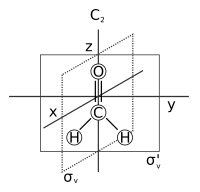
Photo from wikipedia
Electron-vibration coupling (or vibronic coupling) of polyatomic molecules in condensed phase have received considerable attention experimentally and theoretically using linear spectroscopy and 4-wave mixing techniques in an effort to probe… Click to show full abstract
Electron-vibration coupling (or vibronic coupling) of polyatomic molecules in condensed phase have received considerable attention experimentally and theoretically using linear spectroscopy and 4-wave mixing techniques in an effort to probe structure and dynamics of the system at hand. For this reason, a detailed study of vibronic coupling in harmonic polyatomic molecules featuring a greater degree of computational efficiency is presented. A full treatment of non-Condon systems whereupon linear and nonlinear Herzberg-Teller vibronic coupling and Duschinsky mixing effects in harmonic systems taking place upon electronic excitation is provided. The utilization of exponential function to express the nuclear dependence of the electronic transition dipole moment, thereby avoiding the finite sum and eigenstate representation that is normally used in computing non-Condon interaction, leads to a simpler electronic transition dipole moment time correlation function with rapid convergence and better numerical stability than previously reported works. A closed-form expression is obtained for the electronic transition dipole moment time correlation function of polyatomic molecules in which linear and nonlinear Herzberg-Teller vibronic coupling and Duschinsky mixing effects are accounted for. An important numerical observation regarding dealing with branch cuts which manifest themselves as discontinuities in the function itself or its first derivative, and are often exhibited by complex-valued correlation functions, is noted and treated using Riemann surfaces approach. The resultant dipole moment correlation function is in turn employed to calculate linear absorption and hole-burning signals accounting for the aforementioned spectroscopic effects. A link between wavelets and the electronic transition dipole moment time correlation function in multidimensional harmonic systems is made in the concluding remarks.
Journal Title: Journal of chemical theory and computation
Year Published: 2020
Link to full text (if available)
Share on Social Media: Sign Up to like & get
recommendations!